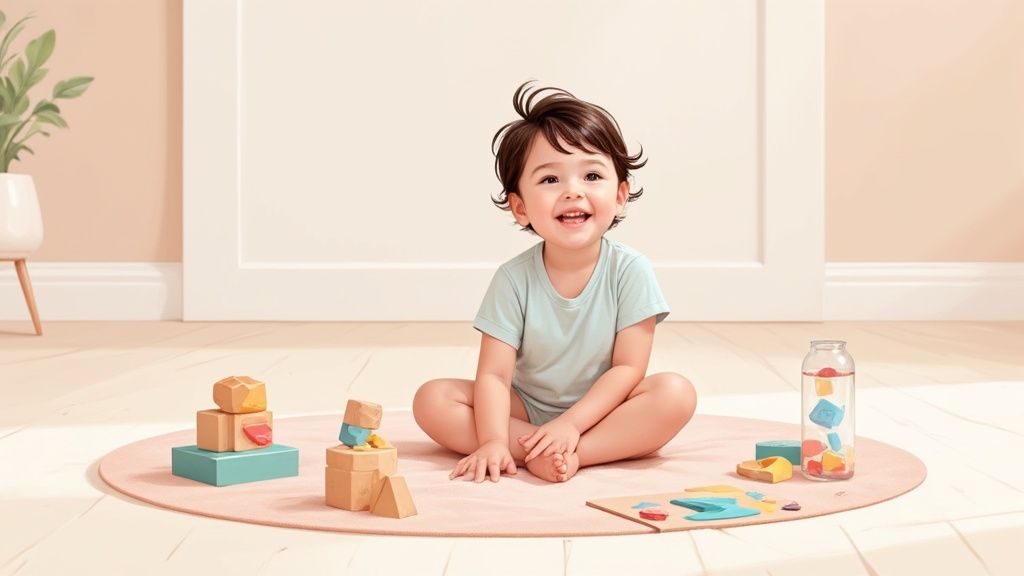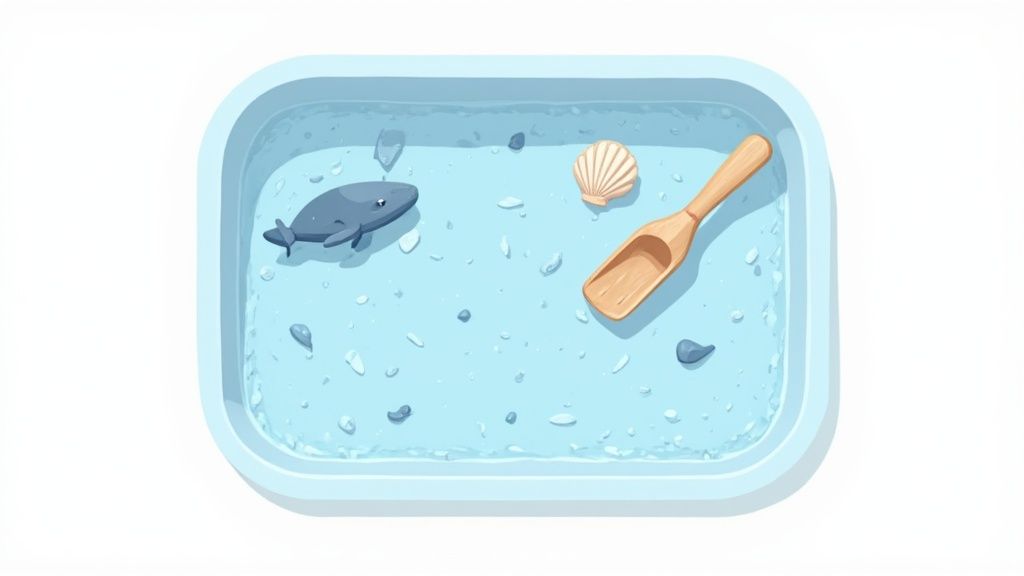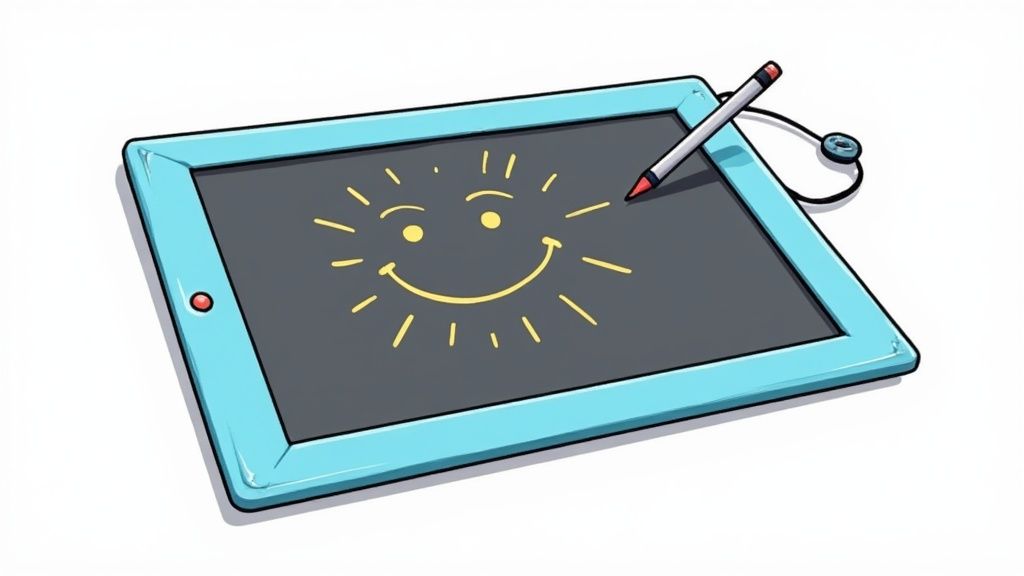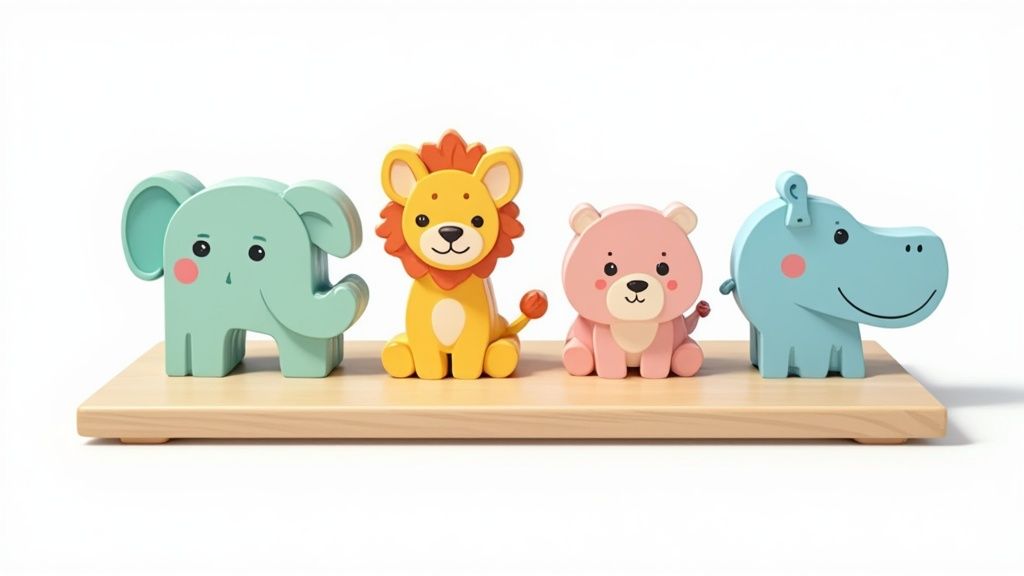7 Quiet Activities for Toddlers to Try in 2025
July 31, 2025

The toddler years are a whirlwind of energy, discovery, and… noise. While embracing their boundless enthusiasm is part of the fun, every parent knows the value of a few moments of peace. Finding engaging, screen-free ways to help your little one settle down can feel like a monumental task. But what if those moments of quiet could also be powerful opportunities for learning and development? This guide is for you.
We've compiled a list of tried-and-true quiet activities for toddlers that don't just occupy them, but also nurture their growing minds and fine motor skills. Forget the endless cycle of loud toys and overstimulating screens. It's time to introduce activities that are calming, creative, and just plain fun. As you begin your parenting journey, it's wise to think ahead. When preparing for your little one, considering what to include on your list of baby registry must-haves can feel overwhelming, but adding items that support this kind of peaceful play is a great start.
Let's dive into some simple ideas that will bring a welcome sense of calm to your home, giving both you and your toddler a chance to recharge without sacrificing engagement or learning.
1. Sensory Bins
A sensory bin is one of the most versatile and engaging quiet activities for toddlers, and for good reason. It’s essentially a contained box or tub filled with tactile materials that invite your little one to explore, scoop, pour, and imagine. The goal is to stimulate their senses, primarily touch, in a focused and calming way.

Popularized by early childhood educators and occupational therapists, these bins are powerhouses for development. As your toddler digs their hands into rice, sand, or water beads, they aren't just playing; they're building crucial fine motor skills, learning early math concepts like volume and measurement, and developing their ability to focus on a single task.
How to Get Started
Setting up a sensory bin is simple and can be tailored to any interest or season. You don’t need expensive materials; many items can be found right in your pantry.
- The Base: Start with a shallow, wide container. An under-bed storage bin or a large roasting pan works perfectly.
- The Filler: This is the main sensory material. Great starters include dried rice, pasta, oats, or beans. For a different texture, try kinetic sand, cloud dough (flour and oil), or even just water.
- The Tools: Add scoops, funnels, measuring cups, and tongs. These tools encourage fine motor practice and hand-eye coordination.
- The Theme (Optional): Add small toys to create a world. Think plastic sea animals in a blue-dyed rice "ocean," or mini construction trucks in a kinetic sand "work site."
Tips for Success
A little prep can make the experience smoother and cleaner for everyone.
Pro-Tip: Place a large shower curtain or an old sheet under the bin. When playtime is over, you can just fold it up and pour any spilled filler right back into the container.
Rotate the fillers and themes every week or two to keep the activity fresh and exciting. This simple change can make an old bin feel brand new. For a deeper dive into how this type of play supports a child's development, you can explore the benefits of sensory integration activities. This approach is fantastic for those moments when you need 30 minutes of independent, focused play, like while you're making dinner or need to take a phone call.
2. Magnetic Drawing Boards
A magnetic drawing board is a classic for a reason and a perfect example of self-contained quiet activities for toddlers. This mess-free marvel uses a magnetic stylus to draw dark lines on a special screen, which can then be instantly erased with a simple slide. It offers all the creative fun of drawing without the need for crayons, paper, or messy clean-up, making it an ideal choice for independent play.

Popularized by brands like Fisher-Price and Melissa & Doug, these boards are fantastic developmental tools in disguise. As your toddler grips the stylus, they are strengthening the small muscles in their hands needed for writing later on. The cause-and-effect action of drawing and erasing builds cognitive skills, while the open-ended nature of the board encourages limitless imagination and artistic expression.
How to Get Started
Most magnetic drawing boards are ready to use right out of the box, but you can enhance the experience with a few simple ideas.
- The Board: Choose a board that fits your needs. Travel-sized versions are perfect for car trips or waiting rooms, while larger boards like the Fisher-Price Doodle Pro offer more space for creativity at home.
- The Tools: The board comes with a magnetic stylus, often tethered so it won’t get lost. Many models, such as the Melissa & Doug deluxe board, also include magnetic shape stamps (circles, squares, triangles) that add another layer of fun and learning.
- The Activity (Optional): Use the board for more than just scribbling. You can practice drawing simple shapes, letters, or numbers together. Play a game of "you draw it, I guess it" to build vocabulary and turn-taking skills.
Tips for Success
A few thoughtful strategies can maximize the developmental benefits and longevity of this toy.
Pro-Tip: Model how to hold the stylus with a "tripod grip" (thumb, index, and middle finger). This isn’t about forcing perfect form, but gently demonstrating the hand position helps build pre-writing readiness in a low-pressure way.
Look for a board with a sturdy frame and an easy-to-use slide eraser for little hands. Keeping an extra stylus on hand (if your model has a detachable one) can be a lifesaver. This activity is perfect for those moments when you need a quick, no-prep distraction that is both engaging and beneficial, allowing your toddler to play quietly while you tackle a task nearby.
3. Busy Books and Quiet Books
A busy book, often called a quiet book, is a brilliant, self-contained quiet activity for toddlers. These are typically soft, fabric-based books filled with interactive pages designed to captivate a child's attention. Each page presents a hands-on challenge, from zipping a tent to buttoning a flower or matching colorful Velcro shapes.

Popularized by Montessori educators and creative parents, busy books are developmental goldmines. They are specifically created to help toddlers practice real-world skills in a safe, engaging way. As your child navigates the laces, snaps, and buckles, they are building fine motor strength, problem-solving abilities, and hand-eye coordination, all while being peacefully engrossed in their own little world.
How to Get Started
You can find beautiful, ready-made busy books online from retailers and Etsy sellers, or you can create a personalized one yourself. The key is to focus on activities that are just challenging enough to be interesting without causing frustration.
- The Base: Most quiet books are made from felt or sturdy fabric pages bound together. If you're making one, felt is very forgiving and doesn't fray.
- The Activities: Think about life skills. A "button snake" is a classic for practicing buttoning. Other pages can feature zippers, snaps, Velcro matching games (colors, shapes, animals), or lacing cards.
- The Theme (Optional): You can center the book around a theme like "A Day on the Farm," with a barn door that unlatches and animals to place in felt pockets, or "Getting Dressed," with pages for tying shoes and zipping jackets.
Tips for Success
The goal is to provide an engaging but not overwhelming experience. Choosing the right book and introducing it at the right time is key.
Pro-Tip: Introduce a new busy book during travel, at a restaurant, or in a waiting room. The novelty will make it an especially powerful tool for keeping your toddler quietly occupied in new or challenging environments.
Start with books that have simpler tasks, like pulling off Velcro pieces, and gradually introduce more complex ones with buttons or ties as your child's dexterity improves. Always inspect the book to ensure all small parts are securely attached to prevent any choking hazards. These books are perfect for pre-nap quiet time or any moment you need focused, independent play.
4. Simple Puzzles
Puzzles are a classic for a reason, and they stand out as one of the best quiet activities for toddlers. An age-appropriate puzzle presents a perfect, self-contained challenge that encourages a toddler to sit, focus, and work through a problem independently. It involves matching shapes, colors, and images, providing a satisfying sense of accomplishment when the final piece clicks into place.

Popularized by educational toy brands like Melissa & Doug and championed by the Montessori method, simple puzzles are fundamental tools for cognitive development. As your toddler manipulates chunky wooden pieces or fits a peg into its correct slot, they are strengthening hand-eye coordination, building spatial awareness, and practicing logical reasoning. This focused play is fantastic for developing patience and persistence in a calm, screen-free way.
How to Get Started
Introducing puzzles is easy and can be adapted as your child's skills grow. The key is to start simple and avoid frustration.
- The Puzzle Type: Begin with puzzles that are easy for little hands to manage. Wooden peg puzzles, where each piece has a small knob, are ideal. Chunky puzzles with large, thick pieces that can stand on their own are also excellent choices.
- The Piece Count: Start small. A puzzle with 4-6 pieces is perfect for a beginner. You can gradually move up to 8-12 pieces as they gain confidence.
- The Theme: Choose puzzles that feature familiar and engaging subjects. Favorites often include farm animals, vehicles, basic shapes, or characters they recognize. Brands like Ravensburger offer "My First Puzzles" series that are designed specifically for this age group.
Tips for Success
A little guidance can transform puzzle time from a potential frustration into a rewarding experience.
Pro-Tip: When introducing a new puzzle, start by taking out just one or two pieces. Let your child master replacing those before you present them with the fully disassembled puzzle. This builds confidence and prevents them from feeling overwhelmed.
Celebrate every small victory and completion to foster a positive association with problem-solving. Rotating your puzzle selection every few weeks keeps the activity feeling fresh and challenging. This type of hands-on manipulation is an excellent way to support your child's development; you can explore more activities that enhance fine motor skills to complement puzzle time. Puzzles are a go-to activity for those moments you need quiet, focused play that is both fun and deeply beneficial.
5. Sticker Books and Activity Pads
Sticker books are a classic for a reason and stand out as one of the best quiet activities for toddlers. This simple, mess-free activity involves peeling stickers and placing them onto scenes or within outlines, providing a satisfying and focused task for little hands. It’s a self-contained world of creativity that can keep a toddler engaged almost anywhere.
Popularized by brands like Melissa & Doug and Usborne, sticker pads are more than just fun. The act of peeling a sticker off a sheet and carefully placing it requires a pincer grasp and hand-eye coordination, which are foundational fine motor skills. As toddlers match stickers to specific spots or create their own scenes, they are also practicing concentration, following directions, and exercising their creativity.
How to Get Started
Getting started with stickers is incredibly easy and requires minimal setup, making it a perfect go-to activity. You can find options for every interest and skill level.
- The Book: Choose a book that matches your child’s interests, like animals, vehicles, or fantasy scenes. The Melissa & Doug reusable sticker pad series is a fan favorite for its durability and value.
- The Stickers: For younger toddlers, start with larger, puffy, or repositionable stickers that are easier for small fingers to peel and handle.
- The Goal: The activity can be as structured or as open-ended as you like. Some books have designated spots for stickers to teach matching, while others provide blank scenes for free play.
- The Space: All you need is a clear surface, like a small table, a lap desk, or even just the floor. This makes it an ideal activity for travel or waiting rooms.
Tips for Success
A few smart strategies can elevate the sticker experience from a simple distraction to a developmental powerhouse.
Pro-Tip: Designate a special, portable "sticker bag" with a few different books and sheets. This keeps everything organized and ready to grab for appointments, car rides, or restaurant waits, turning potential meltdowns into moments of calm focus.
Once a sticker book is complete, don't just toss it. It can become a "look and find" book. Ask your toddler to point to all the blue items or count the animals they placed on the page. This extends the life of the activity and reinforces learning concepts like colors and numbers.
6. Play Dough and Modeling Clay
There's a timeless magic to a simple ball of play dough, making it one of the most beloved quiet activities for toddlers. This tactile activity involves squishing, rolling, and molding a soft, pliable material into anything a child can imagine. It’s an inherently focused and calming process that keeps little hands busy and minds engaged.
Popularized by educators and occupational therapists, play dough is a developmental powerhouse. Manipulating the dough builds immense hand and finger strength, which is essential for future writing skills. As toddlers create shapes and figures, they are also exploring cause and effect, developing spatial awareness, and unleashing their creativity in a three-dimensional way.
How to Get Started
Setting up a play dough station is quick, easy, and endlessly adaptable. You can use store-bought kits or create your own dough with simple pantry ingredients for a more personalized experience.
- The Base: Use a smooth, non-porous surface. A silicone baking mat, a plastic placemat, or a large tray works perfectly to define the play space and contain the mess.
- The Dough: Start with store-bought Play-Doh, soft modeling clay, or even therapeutic putty. For a fun DIY project, make homemade salt dough (flour, salt, and water).
- The Tools: Simple tools elevate the experience. Offer plastic cookie cutters, a child-safe rolling pin, blunt plastic knives, and textured items like buttons or beads to press into the dough.
- The Theme (Optional): Introduce a theme to guide play. Provide green and brown dough with small plastic dinosaurs for a prehistoric world, or use blue and white dough with glitter for a "frozen" winter scene.
Tips for Success
A few simple strategies can make play dough time more enjoyable and extend the life of your materials.
Pro-Tip: Make your own dough and add a few drops of calming essential oil, like lavender or chamomile. This adds an aromatherapy element that can make the activity even more soothing for an overstimulated toddler.
Always store your dough in an airtight container or zip-top bag to keep it from drying out. Rotating the tools and colors every so often will keep the activity feeling new and exciting. For more ideas on how this type of hands-on play benefits children, you can explore the wide world of sensory activities for kids. This activity is perfect for those moments when you need a calming, independent activity to help your toddler wind down before a nap or settle into a quiet evening.
7. Sorting and Matching Activities
Sorting and matching are classic quiet activities for toddlers that tap into their natural desire to create order from chaos. At its core, this activity involves giving your child a mixed group of items and letting them organize them based on a shared characteristic like color, shape, size, or type. It’s a beautifully simple, methodical task that calms the mind and sharpens the eye.
Popularized by the Montessori method and championed by early childhood educators, sorting games are cognitive powerhouses. When your toddler meticulously separates red pom-poms from blue ones or finds the correct lid for each container, they are doing more than just playing. They are building a foundation for mathematical concepts, enhancing their logical reasoning, and developing the fine motor skills needed to carefully pick up and place small objects.
How to Get Started
You don't need fancy toys to introduce sorting; your home is already full of perfect materials. The key is to present them in an inviting and organized way.
- The Container: A muffin tin or an ice cube tray is perfect for separating items into categories. Small bowls also work well.
- The Materials: Gather items with distinct differences. Start with sorting by a single attribute, like color. Good options include colored pom-poms, large buttons, blocks, or even different types of pasta.
- The Task: For matching, gather pairs of items like socks, picture cards, or a set of containers and their corresponding lids.
- The Setup: Arrange the materials on a tray or a mat to define the play space and make cleanup easier.
Tips for Success
A few simple strategies can make these activities more engaging and effective, keeping frustration low and focus high.
Pro-Tip: Start with very obvious differences. Sorting two high-contrast colors (like red and yellow) is much easier for a beginner than sorting shades of blue. As your toddler masters the skill, you can gradually introduce more complexity.
Always praise the effort, not just the "correct" outcome. The goal is the process of thinking and trying. Rotate the materials regularly to keep the challenge fresh. This is an ideal activity for those moments when you need your toddler to engage in focused, independent play, helping them build concentration in a peaceful, satisfying way.
Quiet Activities for Toddlers: 7-Item Comparison
| Activity Type | Implementation Complexity 🔄 | Resource Requirements ⚡ | Expected Outcomes 📊 | Ideal Use Cases 💡 | Key Advantages ⭐ |
|---|---|---|---|---|---|
| Sensory Bins | Medium - setup and cleanup needed | Low - inexpensive materials | Develops fine motor & sensory processing | Calming, focused play; motor skill development | Multi-sensory engagement; customizable themes |
| Magnetic Drawing Boards | Low - ready to use | Low - device and stylus | Encourages creativity, pre-writing skills | Mess-free creative play; travel-friendly | Mess-free; reusable; quiet operation |
| Busy Books and Quiet Books | High - handmade or bought | Medium - cost of fabric books | Builds fine motor skills and quiet focus | Independent quiet play; travel; skill-building | Silent; tactile; durable; personalized |
| Simple Puzzles | Low - ready to use | Low - purchase or gifted | Enhances problem-solving and spatial reasoning | Focused, quiet play; cognitive development | Builds reasoning; contained; confidence boost |
| Sticker Books & Activity Pads | Low - ready to use | Low to medium - books and stickers | Fine motor development; creativity | Quiet, portable play; learning colors/counting | Engaging; quiet; travel-friendly |
| Play Dough & Modeling Clay | Medium - preparation & cleanup | Medium - materials and tools | Hand strength, creativity, sensory input | Calm, creative, sensory-rich play | Therapeutic; creative; inexpensive |
| Sorting and Matching Activities | Low - simple setup | Low - household items or toys | Develops logical thinking and attention | Quiet, methodical play; cognitive skills | Uses everyday items; promotes independence |
Embracing Calm: Your Next Steps to Peaceful Play
Navigating the vibrant, often chaotic, world of toddlerhood can feel like a constant search for the volume knob. As we've explored, finding those precious moments of peace doesn't require complex setups or expensive toys. The key lies in simple, engaging, and screen-free invitations to play. From the tactile exploration of a sensory bin to the focused problem-solving of a simple puzzle, you now have a toolkit filled with effective quiet activities for toddlers that do more than just occupy their time; they nurture their developing minds.
These activities, including busy books, play dough, and sorting games, are the building blocks for crucial skills. They foster concentration, fine motor control, and the invaluable ability to engage in self-directed play. By introducing these moments of calm into your daily rhythm, you are not just managing noise levels; you are teaching your child how to find stillness, focus their attention, and discover the joy of quiet creation. This foundation is a gift that supports learning and emotional regulation long after the toddler years have passed.
Putting Peaceful Play into Practice
So, where do you go from here? The most important takeaway is that consistency trumps complexity. You don't need to introduce all seven activities at once. Instead, try these actionable steps to weave quiet time into your family’s routine:
- Start Small: Choose just one or two activities from this list that you think your toddler will love. Maybe it's the satisfying click of a magnetic drawing board or the creative freedom of sticker books. Dedicate a 10-15 minute "quiet time" slot each day to this specific activity.
- Create a "Quiet Corner": Designate a cozy spot in your home with a small basket or shelf holding a few of these activities. This makes it easy for your toddler to access them independently and signals that this is a space for calm play.
- Rotate and Refresh: Toddlers thrive on novelty. To keep them engaged, rotate the toys and materials every week or two. Swapping out the pasta in a sensory bin for dried beans, or introducing a new, slightly more challenging puzzle, can reignite their interest.
Remember, the goal isn't silent, motionless perfection. It's about creating an atmosphere where your child can decompress, explore, and learn at their own pace. Some days, quiet time will last five minutes; on others, you might get a glorious half-hour. Embrace the process and celebrate the small victories. By intentionally cultivating these peaceful interludes, you're not just finding a moment's rest for yourself; you're equipping your child with the tools for a lifetime of focused, imaginative, and tranquil engagement.
Ready to add an endlessly creative and personalized option to your quiet time rotation? With ColorPageAI, you can instantly generate unique coloring pages of literally anything your toddler can dream up, from smiling volcanoes to astronaut cats. It's the perfect way to keep quiet activities for toddlers fresh, engaging, and tailored perfectly to their interests. Visit ColorPageAI to create your first custom coloring sheet in seconds
Ready to start coloring?
Join ColorPage.ai today and get 5 free credits to create your own custom coloring pages!
Start creating